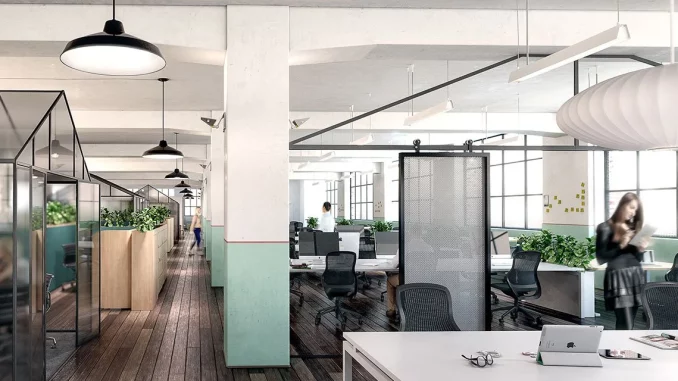
Welcome to a world where workspaces are no longer confined by traditional boundaries but instead embrace the dynamic nature of collaboration and flexibility. As we step into the future of work, it’s essential to explore how design plays a pivotal role in shaping environments that foster innovation, creativity, and productivity. Join us on a journey through the evolution of workspaces as we delve into the realm of designing for collaboration and flexibility.
The Future of Workspaces: Designing for Collaboration and Flexibility
In the realm of workspace design, Geeta Vaibhav Architects are at the forefront of creating innovative environments that promote collaboration and flexibility. Their visionary approach integrates cutting-edge concepts to redefine traditional office spaces.
Agile design is revolutionizing how workspaces adapt to changing needs, allowing for seamless transitions between individual focus and group interactions. This dynamic shift in architectural thinking paves the way for a more fluid and adaptable workplace experience.
Embracing technology as a tool for transformation, offices are evolving into interconnected hubs where employees can seamlessly collaborate regardless of physical location. By leveraging digital solutions, companies enhance communication channels and streamline workflow processes.
The challenges in designing for collaboration and flexibility lie in balancing functionality with aesthetic appeal while ensuring ergonomic comfort and productivity. Finding creative solutions to these obstacles leads to inspiring workspaces that empower individuals and teams alike.
Embracing Flexibility and Collaboration in Workspace Design
In the ever-evolving landscape of workspaces, flexibility and collaboration are becoming key pillars in design concepts. Geeta Vaibhav Architects stand out for their innovative approach to creating dynamic environments that foster teamwork and adaptability.
Agile design principles play a vital role in shaping modern office spaces, allowing for seamless transitions between individual focus and group activities. Technology is revolutionizing how we interact within work settings, enhancing communication and connectivity like never before.
Challenges arise when integrating new technologies into existing office structures, but solutions exist to streamline this process effectively. By transforming construction methods to prioritize agility, companies can stay ahead in creating flexible and collaborative workspaces that meet the demands of today’s workforce.
As we look towards the future, embracing flexibility in workspace design will be crucial for businesses aiming to thrive in an ever-changing world where collaboration reigns supreme.
Geeta Vaibhav Architects
Geeta Vaibhav Architects is a visionary design firm pushing the boundaries of workspace creativity. Their innovative approach combines functionality with aesthetic appeal, creating dynamic environments that inspire collaboration and flexibility.
With a keen eye for detail and a passion for sustainable design, Geeta Vaibhav Architects seamlessly blend form and function in their projects. From open-concept offices to cozy breakout areas, each space is meticulously crafted to enhance productivity and well-being.
By integrating natural elements and modern technology, Geeta Vaibhav Architects redefine traditional workspaces into vibrant hubs of interaction and innovation. Their designs reflect a deep understanding of how architecture influences human behavior, fostering creativity and connection among employees.
Through their unique perspective on spatial dynamics, Geeta Vaibhav Architects continue to shape the future of workspaces by prioritizing collaboration, flexibility, and adaptability.
Agile Design
Agile design is a game-changer in the world of workspace innovation. It’s all about flexibility, adaptability, and responsiveness to change. Imagine an office space that can effortlessly transform based on evolving needs – that’s the essence of agile design.
With agile design principles, workspaces can be easily modified to accommodate different tasks or team sizes. This dynamic approach empowers employees to work more efficiently and creatively by providing them with environments tailored to their specific requirements.
Incorporating agile design elements like modular furniture, movable partitions, and multi-functional spaces allows for seamless transitions between individual focus work and collaborative projects. By embracing agility in office design, companies can foster a culture of innovation and productivity among their teams.
The beauty of agile design lies in its ability to evolve with the ever-changing demands of modern work dynamics. It encourages creativity, collaboration, and efficiency while ensuring that workspaces remain adaptable to whatever challenges the future may bring.
Transforming Office Spaces with Technology
As we step into the future of workspaces, technology plays a pivotal role in transforming office spaces. From smart lighting systems that adjust based on occupancy to digital collaboration tools that connect teams seamlessly, the integration of technology is revolutionizing how we work.
Innovative solutions like virtual reality meeting rooms and AI-powered assistants are reshaping traditional office setups. These advancements not only enhance productivity but also foster creativity and collaboration among team members.
By leveraging data analytics and IoT devices, companies can optimize space utilization and create more efficient working environments. Additionally, cloud-based platforms enable remote work capabilities while ensuring seamless connectivity for dispersed teams.
Embracing augmented reality applications and interactive displays further enriches the employee experience, making workplaces more engaging and dynamic. As technology continues to evolve rapidly, organizations must adapt their office spaces to stay ahead in this ever-changing landscape.
Elevating Collaboration through Design
Collaboration in the workspace is more than just sharing a physical space; it’s about creating an environment that fosters teamwork and innovation. When design elements are strategically incorporated, they can elevate collaboration to new heights.
Open floor plans with designated collaborative zones encourage spontaneous interactions and idea-sharing among team members. Incorporating comfortable seating areas, writable walls, and integrated technology further enhance the collaborative experience.
Natural light, biophilic elements, and vibrant colors can create a stimulating atmosphere that promotes creativity and engagement. By thoughtfully designing spaces that cater to different work styles and preferences, collaboration becomes seamless and dynamic.
Flexible furniture arrangements allow for quick reconfigurations based on project needs or team sizes, enabling fluid collaboration across departments. Embracing diverse work settings within the office landscape ensures that employees have options to collaborate effectively while respecting individual workflows.